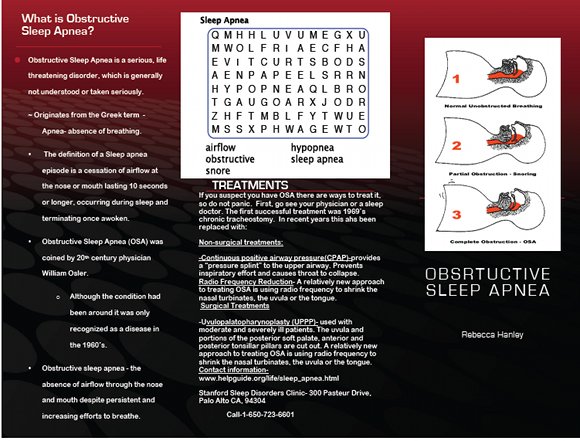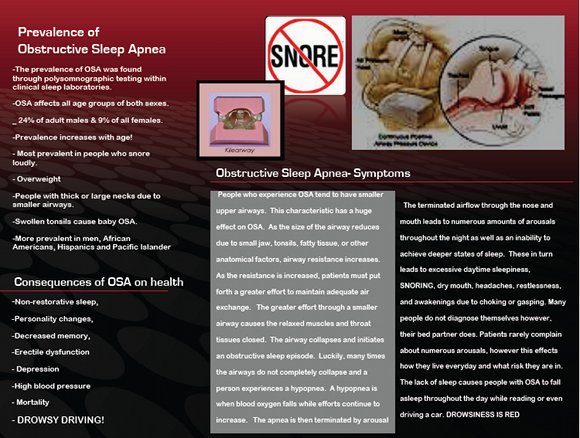
| Connect & Subscribe |
Obstructive Sleep Apnea Brochure
An Outreach Project by Rebecca Hanley | Return To Outreach Projects 2010
The following is a brochure created for Stanford Sleep and Dreams. If it is difficult to read using the images, you may view the full text here.
Also feel free to download this brochure for distributional or general information purposes. Please refer to our privacy policy for our relevant disclaimers.


What is Obstructive Sleep Apnea?
Obstructive Sleep Apnea is a serious, life threatening disorder, which is generally not understood or taken seriously.
~ Originates from the Greek term - Apnea- absence of breathing.
Prevalence of Obstructive Sleep Apnea
-The prevalence of OSA was found through polysomnographic testing within clinical sleep laboratories. -OSA affects all age groups of both sexes.
Consequences of OSA on health
Obstructive Sleep Apnea - Symptoms
People who experience OSA tend to have smaller upper airways. This characteristic has a huge effect on OSA. As the size of the airway reduces due to small jaw, tonsils, fatty tissue, or other anatomical factors, airway resistance increases. As the resistance is increased, patients must put forth a greater effort to maintain adequate air exchange. The greater effort through a smaller airway causes the relaxed muscles and throat tissues closed. The airway collapses and initiates an obstructive sleep episode. Luckily, many times the airways do not completely collapse and a person experiences a hypopnea. A hypopnea is when blood oxygen falls while efforts continue to increase. The apnea is then terminated by arousal.
The terminated airflow through the nose and mouth leads to numerous amounts of arousals throughout the night as well as an inability to achieve deeper states of sleep. These in turn leads to excessive daytime sleepiness, SNORING, dry mouth, headaches, restlessness, and awakenings due to choking or gasping. Many people do not diagnose themselves however, their bed partner does. Patients rarely complain about numerous arousals, however this effects how they live everyday and what risk they are in. The lack of sleep causes people with OSA to fall asleep throughout the day while reading or even driving a car. DROWSINESS IS RED ALERT!!!!!!!!!!!!!
Treatments
If you suspect you have OSA there are ways to treat it, so do not panic. First, go see your physician or a sleep doctor. The first successful treatment was 1969's chronic tracheostomy. In recent years this ahs been replaced with:
Non-surgical treatments:
-Continuous positive airway pressure(CPAP)-provides a "pressure splint" to the upper airway. Prevents inspiratory effort and causes throat to collapse.
Radio Frequency Reduction- A relatively new approach to treating OSA is using radio frequency to shrink the nasal turbinates, the uvula or the tongue.
Surgical Treatments
-Uvulopalatopharynoplasty (UPPP)- used with moderate and severely ill patients. The uvula and portions of the posterior soft palate, anterior and posterior tonsillar pillars are cut out. A relatively new approach to treating OSA is using radio frequency to shrink the nasal turbinates, the uvula or the tongue.
Contact information-www.helpguide.org/life/sleep_apnea.html
Stanford Sleep Disorders Clinic- 300 Pasteur Drive, Palo Alto CA, 94304
Call-1-650-723-6601
About This Site
Welcome! This site is continuously being created by students of Dr. William C. Dement's Sleep And Dreams course at Stanford University.
We made this site as a call to action for people all over the world to live healthier, happier, safer, and more productive lives by learning about their own sleep. We have faith that reading the information provided on this site will motivate you to be smart about your sleep deprivation and strategic about your alertness in order to live life to your fullest, most energetic potential.
In fact, we challenge you to do so! What do you say, are you up for the challenge?
Interviews With Sleep Specialists: Insights Into the Worlds of Sleep Medicine & Sleep Business
America's Most Dangerous Disorder: What Is Sleep Apnea Doing To Your Sleep?
Sleep Debt: How Much More Will You Achieve When You Reduce Yours?
The Stages Of Sleep: The Journey Through The Night
Delayed Sleep Phase: You Want To Sleep But You're Not Tired Yet
Paralyzed at Night: Is Sleep Paralysis Normal?
Sleep In Words: Smart, Strange, and Funny Quotes About Sleep
Sleep Disorders In Children: What's Keeping Your Child From A Full Night's Rest?
Attacks of Pavor Nocturnus (a.k.a. Sleep Terrors, Night Terrors, or Incubus Attacks)
The Stanford Sleep Book
Dr. Dement's pioneering textbook has been the core text for Sleep and Dreams since 1980, but it has just recently been made available to the wider public for the first time.
In it you'll find a more detailed account of the most important things you need to know about sleep, alertness, dreams, and sleep disorders. Studies, statistics, plus plenty of Dr. Dement's classic anecdotes painting the history of sleep medicine.
Preface | Intro | Contents | Get A Copy
More Sleep Resources
The Zeo
A revolution in personal sleep tracking, the Zeo is a wireless headband that transmits your brainwaves in realtime to a dock (pictured here) or your smartphone. The result? You can wake up and see exactly what stages of sleep you were in during the night! Unprecedented personalized sleep knowledge.
Sleep Paralysis: A Dreamer's Guide
Ever woken up paralyzed? A surprising number of us have, believe it or not. But few know the actual causes of this phenomenon, and fewer still how to exert control over it. Dream researcher and sleep paralysis expert Ryan Hurd shares breakthrough insights into how to do just that.
Important Disclaimer
Please Note:
The information found on this page and throughout this site is intended for general information purposes only. While it may prove useful and empowering, it is NOT intended as a substitute for the expertise and judgments of healthcare practitioners.
For more info, see our
Terms of Use.









